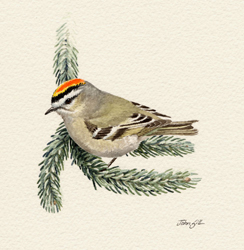Breeding Bird Atlases (BBA)
Find a Bird - BBA1
Breeding Bird Atlas 1 Species Accounts
Golden-crowned Kinglet
Regulus satrapa
Egg Dates
May to June 29
Number of Broods
one; may re-lay if first attempt fails.

The diminutive Golden-crowned Kinglet is found in Massachusetts throughout the year, but as a breeding bird it is largely limited to the spruce-clad hill country of the Berkshires. When found apart from our coniferous uplands, it is inevitably in plantings of tall spruces, often the Norway Spruces that have been popular for landscaping since the mid-nineteenth century and were planted in watersheds surrounding reservoirs built in the 1930s. Many of these spruces now exceed a hundred years of age and reach 75 feet or more in height, and have been found in many northeastern states to be attracting kinglets far from the usual breeding grounds. Nesting kinglets are inconspicuous birds, but careful searches of mature spruce plantings in eastern Massachusetts might increase the number of known breeding sites.
Golden-crowned Kinglets are best known as transients, more common in fall than spring. They are seldom abundant and are generally found in conifers, often in White Pines. Both as migrants and as less common wintering birds, they are difficult to find high in evergreens, and their high-pitched, lispy notes are hard to hear as the active wing-flickering kinglets flutter about the tips of branches overhead. They are often members of mixed foraging flocks of chickadees, titmice, nuthatches, and creepers. The kinglets remaining in Massachusetts by winter’s end are augmented in April and early May by transients. Any Golden-crowned Kinglet discovered by late May or June in conjunction with ornamental spruces or watershed spruce plantations should be studied for indications of nesting. Some kinglets are believed to be permanent residents of their breeding sites, with the migrants being from more northern nesting areas.
The lisping, often trisyllabic call notes of the Golden-crowned Kinglet, difficult as they are to hear, are better known than the high squeaky song, which is a far less impressive effort than the loud, rollicking, musical song of the Ruby-crowned Kinglet. Unlike the Ruby-crowned Kinglet, which regularly sings during migration, the Golden-crowned Kinglet is seldom heard except on the breeding grounds.
Nesting begins in mid- to late May and extends through early July. The small, deep, cup nest is suspended from a branch, usually near the tip and often at a great height. Three nests in Winchendon were located in evergreen woods as follows: one 60 feet high and 2 feet from the top of a spruce, one 50 feet high and 20 feet from the top of a spruce, and one at a height of 30 feet. These nests were constructed of moss, lichen, bark, rootlets, and feathers, and each contained deep hollows for the eggs (Brewster 1888). An interesting record for a nest in eastern Massachusetts is that of one in Stoughton discovered in a Red Cedar. The tree was 20 feet in height, and the nest was located 18 feet up on a small branch near the trunk (Blake 1916).
The clutch sizes range from five to ten (average eight or nine) eggs, and for 3 state nests were as follows: eight eggs (1 nest), nine eggs (2 nests) (Brewster 1888). Hatching after a two-week incubation period, the bumblebee-sized nestlings are attended by both parents. The sole record for a state nestling date is May 30 (BOEM). Family groups of fledglings, looking much like adults but lacking any yellow or orange on the crown, apparently remain together for several weeks, and are still fed by the parents as they learn to forage for themselves amidst the conifers. Fledglings have been observed in Massachusetts on July 4 and July 9 (BOEM, Blodget).
After completion of the August molt, the adults and young are indistinguishable. By mid-September, they begin appearing in areas where they have not nested, and in this season they may be found in thickets and in deciduous woods, as well as in conifers. Fall migrants pass through from mid-September through November, after which numbers again decrease. Variable numbers remain in Massachusetts for the winter, but most move to the southern half of the United States.
Map Legend and Data Summary
Atlas 1 data collected from 1975-1979


Note: locally uncommon in spruces at higher elevations of western regions; recently found nesting in maturing spruce plantations near reservoirs in eastern Massachusetts
Kathleen S. Anderson



